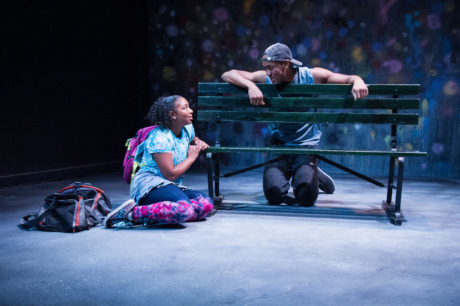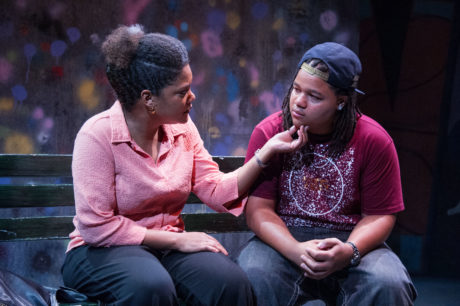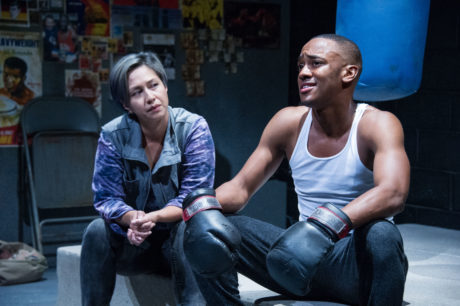Yesterday at The Anacostia Playhouse, the real world and the world onstage converged. It was like a communal emotion-meld through theater, the human heartbreak untold in too many headlines become the pulse of a singularly heartrending play.

Playwright Kimber Lee was moved to write brownsville song (b-side for tray) in response to the shooting death of a real young man named Tray Franklin in Brownsville, Brooklyn. Lee did not want Franklin to be a statistic, another name in the endless eulogies and obituaries about young black men whose lives ended in gun violence. So Lee created a character named Tray, borrowed aspects of his life from the real Tray—a teen with a passion for boxing, a scholarship he was awarded on the strength of a personal essay, and a father who too was shot to death, when Tray was a boy. Lee then imagined the family that her Tray left behind, the family who loved him and now lived with his absence.
That might sound all mordant and mournful. But brownsville song is anything but. Because the extraordinary cast and director have found such overflowing hope and love in Lee’s lyrical script that our emotional experience follows along as if buoyed by a coursing current. And the story is told with a marvelous ebb and flow in time, such that for long passages we and his family are face to face with Tray before he was shot.
Tray’s grief-stricken grandmother, Lena, begins the play just after that. She has a monologue. She wants us to understand that her grandson Tray was a good kid. Not a gang member. Nothing to do with drugs. He had a promising future. “He was not the same old story,” she says. And from her very first words, we are in the presence of an astounding actor, Lolita Marie, who is playing the part as if from the depths of Lena’s soul. For the next ninety minutes there will not be a nanosecond when Marie is onstage that we are not enthralled by her.

Lena is Tray’s “Grams.” She’s really like a mother to him, on his case about completing that scholarship essay. He’s disgruntled by her nagging, but as the play unfolds a beautiful warmth between them is revealed. Sideeq Heard, who plays Tray, positively radiates emotional presence on stage when he is solo, addressing several monologues directly to the audience, but never more so than in the scenes he shares with Lena and his kid sister, Devine.
Devine, played with the sweetest enthusiasm by Kita Grayson, has scenes with Tray more imagined than real in which the two dance together. Director Paige Hernandez, whose sensitive conception for this show sweeps us up in each scene, also did the choreography. Heard’s and Grayson’s moves are delightful.
Tray and Devine have lived with Lena since their father was killed and Devine’s mother, Merrell, left them. Tray’s father and Merrell got together after Tray’s birth mother died. The backstory on these familial relationships falls into place piecemeal but always in time for us to understand the tensions—particularly the intrafamily strife that Merrell brings.
Merrell is one complex and challenging character—Tray’s father was black and she’s not, she abandoned Devine and Tray, she spent time in rehab. Regina Aquino has found a through-line and center for Merrell that in the end becomes extremely touching.
And Avery Collins’ appealing performance keeps it real in two supporting roles: Junior, a pal of Tray’s who was with him when he was shot, and a college student who drops in the Starbucks where Tray works as a barista.
Debra Kim Sivigny’s sprawling set and smart costumes effectively serve the story’s characters and time-and-place shifts (including a park, a bedroom, a kitchen, a boxing gym). Lighting and sound by William K. D’Eugenio contribute enormously to the show’s flow, and Nick tha Ida’s original music brings terrific pop-culture specificity.

At one point Tray explains what bonds him, his Grams, and his sister: “We hold on tight and we ain’t let go,” he says. At another point, now speaking from after death, he exhorts us the audience “to write hope into your own story.” The onslaught outside of gun violence and senseless killings could easily make this play feel too timely, too topical, too true to life.
But what Theater Alliance achieves with Kimber Lee’s brownsville song (b-side for tray) is something else entirely. When you see it you’ll feel it. It’s hope to hold on tight to.
Run Time: 90 minutes, with no intermission.
brownsville song (b-side for tray) plays through October 9, 2016 at Theater Alliance performing at The Anacostia Playhouse – 2020 Shannon Place SE, in Washington, DC. For tickets, purchase them online.
RATING:





